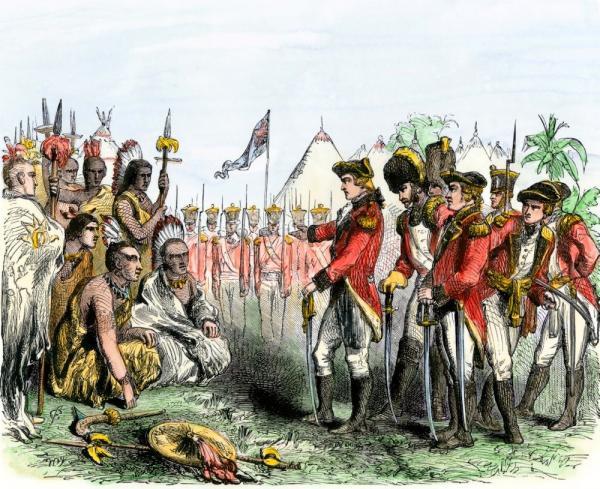
Tribal economies were seriously disrupted by British actions. By 1759 the British had begun to engage in a scorched-earth policy that led to the indiscriminate destruction of native towns, including those of the Cherokee and other British-allied tribes. During the French and Indian War (1754–63) they allied themselves with the British the French had allied themselves with several Iroquoian tribes, which were the Cherokee’s traditional enemies. By the early 18th century the tribe had chosen alliance with the British in both trading and military affairs. The Spanish, French, and English all attempted to colonize parts of the Southeast, including Cherokee territory. An important religious observance was the Busk, or Green Corn, festival, a firstfruits and new-fires celebration. A typical Cherokee town had between 30 and 60 such houses and a council house, where general meetings were held and a sacred fire burned. Cherokee dwellings were bark-roofed windowless log cabins, with one door and a smoke hole in the roof. Deer, bear, and elk furnished meat and clothing. They wove baskets, made pottery, and cultivated corn (maize), beans, and squash. When encountered by Spanish explorers in the mid-16th century, the Cherokee possessed a variety of stone implements, including knives, axes, and chisels. Who was the Shawnee chief, orator, military leader, and advocate of intertribal Indian alliance who directed resistance to white rule in the Ohio River valley? In the War of 1812 who joined British forces for the capture of Detroit and the invasion of Ohio? Test your knowledge. The peace towns provided sanctuary for wrongdoers war ceremonies were conducted in red towns. The chiefs of individual red towns were subordinated to a supreme war chief, while the officials of individual white towns were under the supreme peace chief. The Cherokee nation was composed of a confederacy of symbolically red (war) and white (peace) towns. Traditional Cherokee life and culture greatly resembled that of the Creek and other tribes of the Southeast.

They are believed to have numbered some 22,500 individuals in 1650, and they controlled approximately 40,000 square miles (100,000 square km) of the Appalachian Mountains in parts of present-day Georgia, eastern Tennessee, and the western parts of what are now North Carolina and South Carolina. Their name is derived from a Creek word meaning “people of different speech” many prefer to be known as Keetoowah or Tsalagi.
#WERE A WARLIKE PEOPLE HOW TO#
COVID-19 Portal While this global health crisis continues to evolve, it can be useful to look to past pandemics to better understand how to respond today.Student Portal Britannica is the ultimate student resource for key school subjects like history, government, literature, and more.From tech to household and wellness products.




 0 kommentar(er)
0 kommentar(er)
